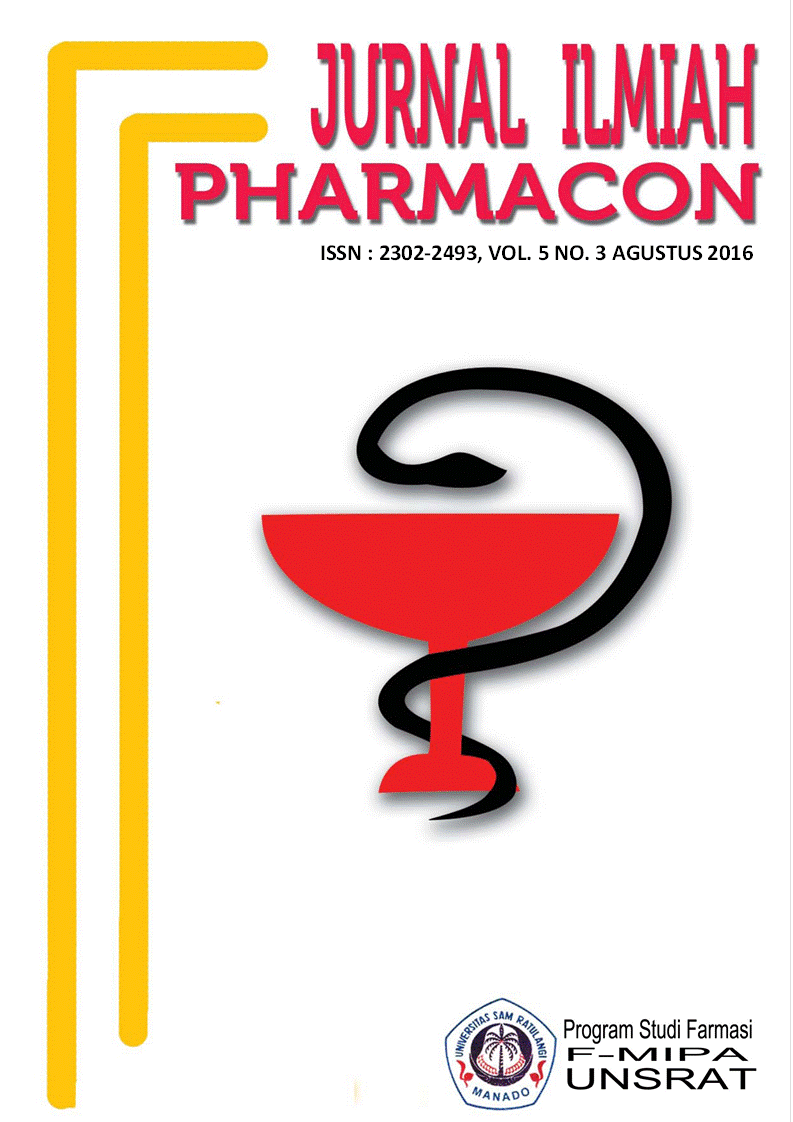UJI DAYAHAMBAT AIR PERASAN BUAH LEMON CUI (Citrus microcarpaBunge) TERHADAP PERTUMBUHAN Candida albicans YANG DIISOLASI DARI PLAT GIGI TIRUAN LEPASAN AKRILIK
DOI:
https://doi.org/10.35799/pha.5.2016.12955Abstract
UJI DAYAHAMBAT AIR PERASAN BUAH LEMON CUI (Citrus microcarpaBunge) TERHADAP PERTUMBUHAN Candida albicans YANG DIISOLASI DARI PLAT GIGI TIRUAN LEPASAN AKRILIK
MargonoRazakIlahi1), Vonny N.S. Wowor1),HeriyannisHomenta2)
1) Program Studi Pendidikan Dokter Gigi Fakultas Kedokteran UNSRAT Manado, 95115
2)Pfakultas Kedokteran UNSRAT Manado, 95115
Â
Â
ABSTRACT
The prevalence of denture stomatitis in Indonesia is quite high. The main cause is the fungus Candida albicans. Untreated cleanliness removable denture acrylic can be a good mediator for the growth of microorganisms in the mouth, including the fungus Candida albicans. One way to care the dentures to keep it clean is soak the denture in a cleaning solution. Lemon cui are common plant in North Sulawesi and the fruits contain citric acid that function as an anti-fungal. This research was a laboratory experimental design with posttest only control group, aims to determine the inhibit potency of juice of lemon cui to the growth of Candida albicans which is isolated from removable denture acrylic plate. Testing method using agar plate diffusion method (Kirby Bauer) in five petri dish. The results showed that the juice of a lemon cui can inhibit the growth of Candida albicans with a mean diameter 8.42 mm of inhibit potency. The conclusion from this study that the juice of a lemon cui have medium inhibit potency to the growth of Candida albicans that isolated from removable denture acrylic plate.
Keywords: juice of lemon cui, Candida albicans, removable denture acrylic plate.
ABSTRAK
Prevalensi denture stomatitis di Indonesia cukup tinggi. Penyebab utamanya adalah jamur Candida albicans. Gigi tiruan lepasan akrilik yang tidak dirawat kebersihannya akan menjadi tempat berkumpulnya plak yang dapat menjadi media yang baik bagi pertumbuhan mikroorganisme dalam mulut termasuk jamur Candida albicans. Salah satu cara untuk membantu menjaga kebersihan gigi tiruan yang digunakan yakni melalui perendaman dalam larutan pembersih. Tanaman buah lemon cui banyak terdapat di daerah Sulawesi Utara dan buahnya mengandung asam sitrat yang bersifat anti jamur. Penelitian ini merupakan penelitian experimental laboratories dengan desain post test only control group, bertujuan untuk mengetahui daya hambat air perasan buah lemon cui terhadap pertumbuhan Candida albicans yang diiisolasi dari plat gigi tiruan lepasan akrilik. Metode pengujian menggunakan metode difusi lempeng agar (Kirby Bauer) pada lima cawan petri. Hasil penelitian menunjukkan bahwa air perasan buah lemon cui dapat menghambat pertumbuhan Candida albicans dengan rerata diameter daya hambat sebesar 8,42 mm. Kesimpulan dari penelitian ini yakni air perasan buah lemon cui memiliki daya hambat sedang terhadap pertumbuhan Candida albicans yang diisolasi dari plat gigi tiruan lepasan akrilik.
Â
Kata kunci: Air perasan buah lemon cui, Candida albicans, plat gigi tiruan lepasan akrilik.
Â
Â
Â
Â
Â
Â
Â
Â
Downloads
Published
How to Cite
Issue
Section
License
Authors who publish with this journal agree to the following terms:
- Authors retain copyright and grant the journal right of first publication with the work simultaneously licensed under a Creative Commons Attribution-NonCommercial 4.0 International License that allows others to share the work with an acknowledgement of the work's authorship and initial publication in this journal.
- Authors are permitted and encouraged to post their work online (e.g., in institutional repositories or on their website) prior to and during the submission process, as it can lead to productive exchanges, as well as earlier and greater citation of published work (See The Effect of Open Access)










